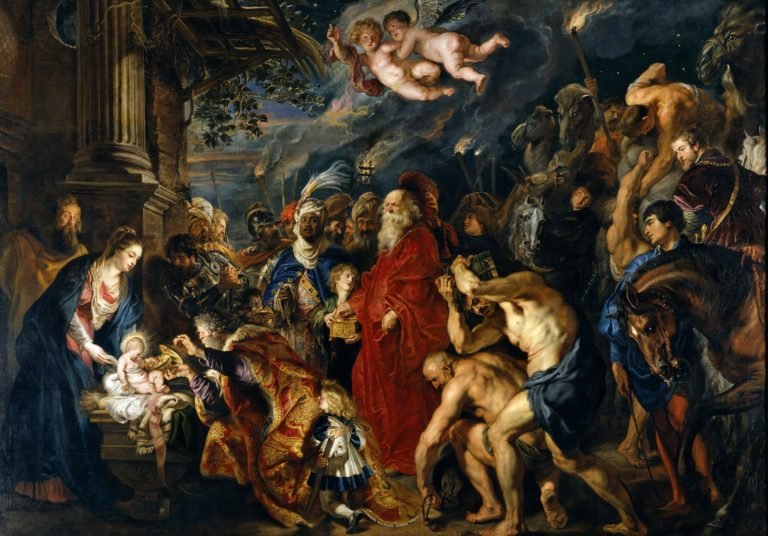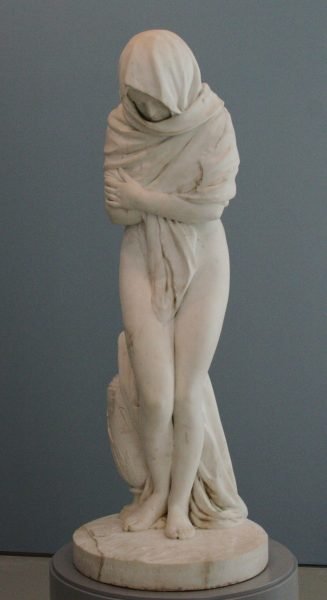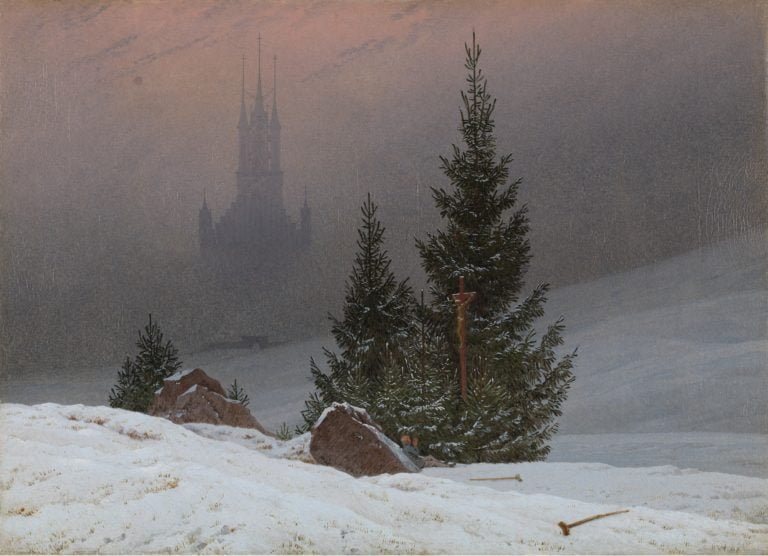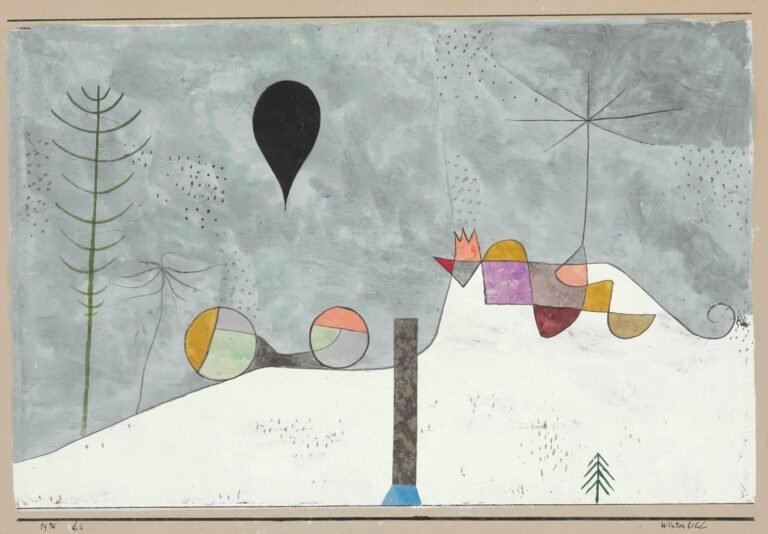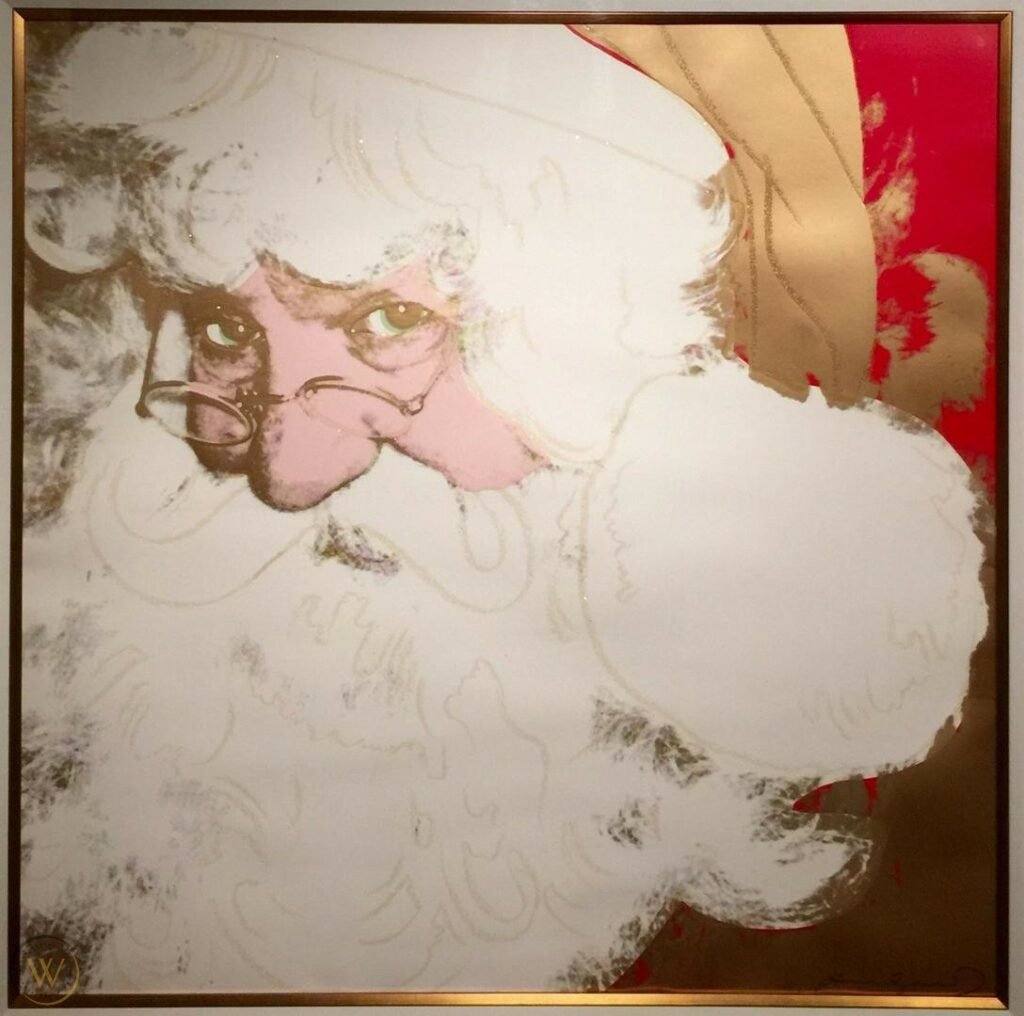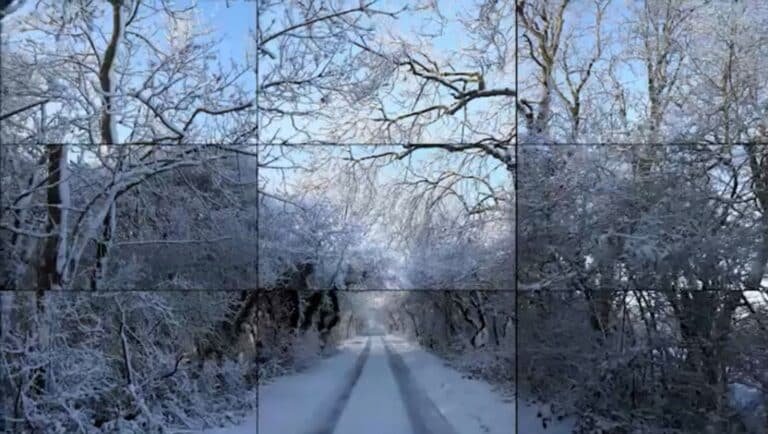No doubt about it, Christmas is approaching fast: in Paris, it gets dark at 5 pm, streets and shop windows are adorned with bright decorations, spreading holiday cheer. The strikes are making it a little less easy to visit museums & exhibitions, but fear not, you can still enjoy some seasonal artworks from the comfort of your own home.
To relish the build-up to Christmas without overindulging in any chocolate or mince pies, discover my selection of ten of the most beautiful works of art inspired by this winter season, ranging from the Renaissance to the present day.
1. Gentile da Fabriano, The Adoration of the Magi, 1423: for its glittering detail
This large altarpiece is full of sumptuous decorative detail and seems to shimmer due to the gilding on the characters’ halos and costumes, and even on the horses’ harnesses! The Adoration of the Magi was commissioned to Gentile da Fabriano by a wealthy banker named Palla Strozzi for his family’s chapel in the Santa Trinità Basilica in Florence.
The painting illustrates an episode from Saint Matthew’s Gospel, according to which “Magi from the East” wished to find and worship the newborn king of the Jews. After following a guiding star, they offered him gold, frankincense and myrrh. The opulent iconography of the serves both the biblical narrative and the material wealth of the patron, shown standing behind the three Wise Kings holding a falcon. Gentile da Fabriano himself appears beside him, looking straight at the viewer. The artist was highly sought after at the time for the refined delicacy of his paintings, his meticulous, colourful details and precious materials. The Adoration of the Magi is considered today a masterpiece of International Gothic style and is an absolute must-see for the Christmas period.
2. Giuseppe Arcimboldo, Winter, 1573: for those who like to remind everyone that Christmas is really about the Winter Solstice…
If you are at all interested in Roman Antiquity, you will know that December 25th was chosen as the date for Christmas in the 4th century AD, to replace the pagan celebration of the Winter Solstice known as “Birth of the Sun“, because from that day forward, the days started getting longer.
In 1563, Giuseppe Arcimboldo, who was court painter to the Habsburgs in Vienna, began to work on a series of profile portraits – reviving the tradition of ancient coins and medals – inspired by the seasons. Arcimboldo probably sought inspiration for his imaginative heads in the parties & masquerades he was in charge of organising for Emperor Maximilian II.
Winter is depicted as an old man with tree bark skin, a moss beard and ivy hair. Two thick mushroom-lips form a scowling mouth. However amusing they may seem, these allegories of the seasons also had a strong political dimension, demonstrating the extent of the Empire and its riches. Winter is an authority figure, since it is at the head of the year – caput anni in Latin – in the same way as the Habsburgs were at the head of their empire. The Louvre’s version of the painting is a copy of the original, made by Arcimboldo for Augustus, Elector of Saxony, in 1573.
3. Pieter Paul Rubens, L’Adoration des Mages, 1628-1629: to get inspired to host a huge gathering
The Adoration of the Magi was one of Pieter Paul Rubens’ favorite subjects – he painted ten to fifteen works on this same theme! This particular version was commissioned to him in 1609 by the city of Antwerp, as he was returning from a trip to Italy. Three years later, the work was gifted to the Spanish ambassador, before being claimed by the Spanish Crown in 1621. Ultimately, Rubens altered the painting during a trip to Madrid, at the court of King Philip IV.
This lively picture is constructed around a diagonal line that directs all the gazes towards Baby Jesus. The latter also concentrates the light in the painting, countered by a strong Caravaggio-inspired chiaroscuro. The painting displays a crowd of colourful, animated characters. The infant Jesus seizes one of the gold coins being offered to him as if it were a host. The three Wise Kings, meanwhile, gather around him, escorted by their children-pages and their slaves – which bear a striking resemblance to Michelangelo’s sculptures of slaves.
In 1628-29, the artist enlarged the painting by adding a top section with angels – in accordance with the principles of the Counter-Reformation – as well as a vertical section on the right. There, Rubens includes a self-portrait of himself, on horseback. Although riding away, he turns to contemplate the scene, or perhaps his detailed, animated work.
4. Jean-Antoine Houdon, Winter, 1783: for those who hate the cold and can’t wait for winter to end
Jean-Antoine Houdon is one of the greatest artists of the 18th century, famous for having sculpted the busts of philosophers such as Voltaire or Diderot. He also created this allegory of Winter, nicknamed La Frileuse – “the Chilly Woman”. Far removed from Arcimboldo’s fantasy, this refined marble sculptures displays a naked young woman, apparently suffering from the cold. Slightly hunched over, she tightly hugs her crossed arms against her chest, trying to warm herself by covering her head and shoulders with a shawl.
In doing so, however, the model reveals the rest of her body to the viewer’s gaze. Her attitude, although “protective”, forms an attractive spiral. The young woman’s sensuality, deemed both shameless and scandalous, added to the presence of a broken pitcher at her feet – a symbol of lost virginity in a painting by Jean-Baptiste Greuze, a contemporary of Houdon – led to Houdon’s work being rejected from the 1783 Salon.
5. Caspar David Friedrich, Winter Landscape, ca. 1811: for its aura of mystery and Christmas spirituality
This small oil on canvas by the most famous German romantic artist, Caspar David Friedrich, is the epitome of winter imagery. It is amazingly atmospheric and you can almost feel the sensation of breathing in the cold, frosty air. At the foot of a cross sheltered by pine trees, a man prays, leaning back against a rock. He seems to have discarded his crutches, abandoned along the way.
Beyond the misty horizon, skillfully rendered by Friedrich by applying tiny strokes of smalt – a blue pigment that creates a transparent effect – appears elegant silhouette of a cathedral. The shapes of the building echo those of the trees. The evergreens, the blades of grass growing through the thick coat of snow, as well as the rosy atmosphere – signifying the approach of dawn – all convey the hope for rebirth and renewal, in accordance with the Christian faith. This Winter Landscape serves the Caspar David Friedrich’s symbolic and spiritual Christmas message.
6. Claude Monet, The Magpie, 1868-1869: to meditate on the colour of snow
I particularly like this painting as it is the first one I ever spoke about in public (in front of my class, in high school!). Painted near Etretat, in Normandy, it offers a tranquil snowy landscape, perfect for contemplation.
In this stable composition, marked by the horizontal lines of the roofs and hedge, the magpie is the only animated being. Perched on the fence like a musical note on a score, the bird highlights the silence around it. The canvas shows visible brushstrokes that vary in shape, thickness and direction. The low winter sunshine projects long shadows which are neither black nor grey, but coloured, as is whole painting. In fact, Monet challenges our mental beliefs (ie. snow is white) with his visual perceptions that show that, at the precise moment when he is observing the landscape, the snow is made out of multiple shades of green, pink, blue, yellow and purple.
Five years before the first Impressionist exhibition, Claude Monet conveys the ephemeral character of the landscape by using the very techniques that made the group both famous and infamous: the coloured shadows, visible brushstrokes, attention to colour and atmospheric light effects.
7. Viggo Johansen, Silent Night, 1891: for the excitement of Christmas Eve
This charming picture of a warm and intimate family Christmas was created in 1891 by Viggo Johansen, a member of the Skagen painters – a colony of artists who gathered in a small fishing village in Denmark, attracted by its landscapes and light. Johansen and his family lived between Skagen and Copenhagen, where he completed this painting.
Viggo Johansen gives us a tender portrait of his wife (Martha) and children, dancing around the Christmas tree with a family friend, as Martha’s aunt watches them benevolently from the corner of the room. The dim light of the living room barely shows the elegant decoration of the room with its vases and the sculpted busts. The lights on the Christmas tree, conversely, radiate all over the room, delighting the children. Johansen’s interest in light effects may have been inspired by Monet, whose work he discovered from 1885 onwards while exhibiting his work in Paris.
The little boy’s gaze on the left, however, seems more attracted to the unique present under the tree – perhaps a reference to the values of love, giving and sharing so often associated with Christmas?
8. Paul Klee, Winter Picture, 1930: for a dreamy, geometric Christmas
This Winter Landscape by Paul Klee shows an irregular horizon with colored forms sliding on it. The movement of these geometric shapes, with their mixture of flat, bold colours and fine contours, are reminiscent of the artist’s search for optical mobility and interest in the composition of white light.
In 1930 Klee, who was precisely working on the balance between the values of white, gray and black, combined all three in this composition: the snowy earth, the sky and a large plane of black. He was not seeking to imitate the landscape he could see, but instead wished to offer analogies between his visual perceptions and his inner world, rearranging shapes and colors as he pleased. So while we may equate the tiny brushstrokes gathered in clusters to snowflakes, or recognise the outline of evergreens, Klee simplified shapes to the extreme, almost to the point of abstraction. All notions of proportion, perspective, shadow and light are reviewed and adapted here, to create a landscape that is above all rhythmical.
9. Andy Warhol, Santa, 1981: to have fun with the commercial aspect of Holiday season
Did you know that Christmas was Andy Warhol’s favorite time of year? He loved its festive spirit, its colours, all the excess and glitter, as well as the emphasis on friendship and sharing… and of course, as a Pop Artist, he was obviously intrigued by its consumerism.
In 1981, Warhol produced a series called Myths. Its purpose was to explore legendary figures of American popular culture, including Mickey Mouse, Uncle Sam, Superman and … Santa Claus – a character whose appearance was, after all, largely shaped in the 1930s by an advertisement for a famous soda brand…
This work is a print made from an enlarged Polaroid photograph transferred to a photosensitive screen, which allowed many copies to be made. On some of them, including this one, Andy Warhol even added diamond powder… enough to add some seasonal flashiness and glamour to the piece.
10. David Hockney, Woldgate Woods, 2010: to wonder at the passing of the seasons
(Click on the image to watch the video).
British artist David Hockney, also considered a major representative of Pop Art, continues to have a prolific work today. After making a series of photocollages in the 1980s, where he combined photographs with slightly displaced viewpoints of a single scene, in 2010 he created a multi-camera video artwork.
At that time, the artist, who lived in the United States for a long time, returned to live in his native Yorkshire and tackled a vast series of outdoor works. In 2009-2010, he began his first drawings on iPhone and then on iPad, before creating a video work on the theme of the four seasons: the first of its kind. Like Claude Monet in his series, Hockney bears witness to the passing of the seasons in one place (Woldgate Woods), thereby offering us an enchanting walk in the English countryside in winter.
Which of these works of art is your favourite? Tell me in the comments!
Wishing you all a very merry Christmas 🙂
Charlotte Wilkins, “10 works of art to get into the Christmas spirit”, 11 December 2019



